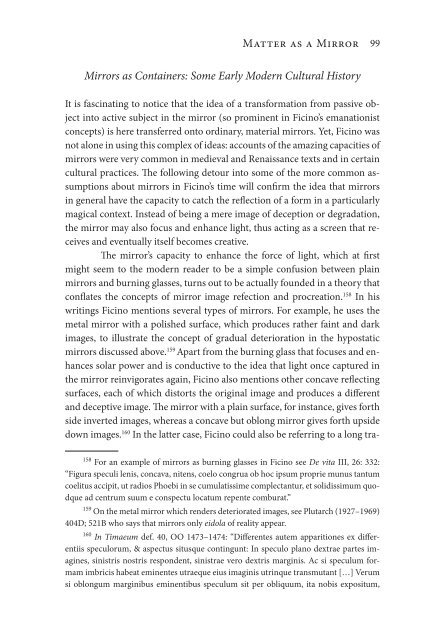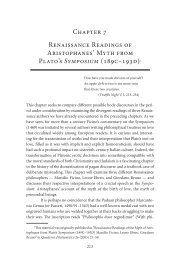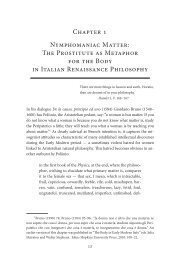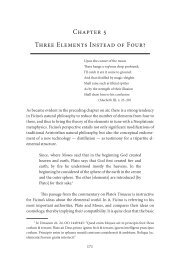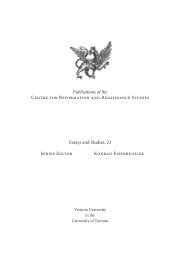Chapter 2 Matter as a Mirror: Marsilio Ficino and Renaissance ...
Chapter 2 Matter as a Mirror: Marsilio Ficino and Renaissance ...
Chapter 2 Matter as a Mirror: Marsilio Ficino and Renaissance ...
You also want an ePaper? Increase the reach of your titles
YUMPU automatically turns print PDFs into web optimized ePapers that Google loves.
<strong>Matter</strong> <strong>as</strong> a <strong>Mirror</strong> 99<br />
<strong>Mirror</strong>s <strong>as</strong> Containers: Some Early Modern Cultural History<br />
It is f<strong>as</strong>cinating to notice that the idea of a transformation from p<strong>as</strong>sive object<br />
into active subject in the mirror (so prominent in <strong>Ficino</strong>’s emanationist<br />
concepts) is here transferred onto ordinary, material mirrors. Yet, <strong>Ficino</strong> w<strong>as</strong><br />
not alone in using this complex of ide<strong>as</strong>: accounts of the amazing capacities of<br />
mirrors were very common in medieval <strong>and</strong> <strong>Renaissance</strong> texts <strong>and</strong> in certain<br />
cultural practices. The following detour into some of the more common <strong>as</strong>sumptions<br />
about mirrors in <strong>Ficino</strong>’s time will confirm the idea that mirrors<br />
in general have the capacity to catch the reflection of a form in a particularly<br />
magical context. Instead of being a mere image of deception or degradation,<br />
the mirror may also focus <strong>and</strong> enhance light, thus acting <strong>as</strong> a screen that receives<br />
<strong>and</strong> eventually itself becomes creative.<br />
The mirror’s capacity to enhance the force of light, which at first<br />
might seem to the modern reader to be a simple confusion between plain<br />
mirrors <strong>and</strong> burning gl<strong>as</strong>ses, turns out to be actually founded in a theory that<br />
conflates the concepts of mirror image refection <strong>and</strong> procreation. 158 In his<br />
writings <strong>Ficino</strong> mentions several types of mirrors. For example, he uses the<br />
metal mirror with a polished surface, which produces rather faint <strong>and</strong> dark<br />
images, to illustrate the concept of gradual deterioration in the hypostatic<br />
mirrors discussed above. 159 Apart from the burning gl<strong>as</strong>s that focuses <strong>and</strong> enhances<br />
solar power <strong>and</strong> is conductive to the idea that light once captured in<br />
the mirror reinvigorates again, <strong>Ficino</strong> also mentions other concave reflecting<br />
surfaces, each of which distorts the original image <strong>and</strong> produces a different<br />
<strong>and</strong> deceptive image. The mirror with a plain surface, for instance, gives forth<br />
side inverted images, where<strong>as</strong> a concave but oblong mirror gives forth upside<br />
down images. 160 In the latter c<strong>as</strong>e, <strong>Ficino</strong> could also be referring to a long tra-<br />
158 For an example of mirrors <strong>as</strong> burning gl<strong>as</strong>ses in <strong>Ficino</strong> see De vita III, 26: 332:<br />
“Figura speculi lenis, concava, nitens, coelo congrua ob hoc ipsum proprie munus tantum<br />
coelitus accipit, ut radios Phoebi in se cumulatissime complectantur, et solidissimum quodque<br />
ad centrum suum e conspectu locatum repente comburat.”<br />
159 On the metal mirror which renders deteriorated images, see Plutarch (1927–1969)<br />
404D; 521B who says that mirrors only eidola of reality appear.<br />
160 In Timaeum def. 40, OO 1473–1474: “Differentes autem apparitiones ex differentiis<br />
speculorum, & <strong>as</strong>pectus situsque contingunt: In speculo plano dextrae partes imagines,<br />
sinistris nostris respondent, sinistrae vero dextris marginis. Ac si speculum formam<br />
imbricis habeat eminentes utraeque eius imaginis utrinque transmutant […] Verum<br />
si oblongum marginibus eminentibus speculum sit per obliquum, ita nobis expositum,


